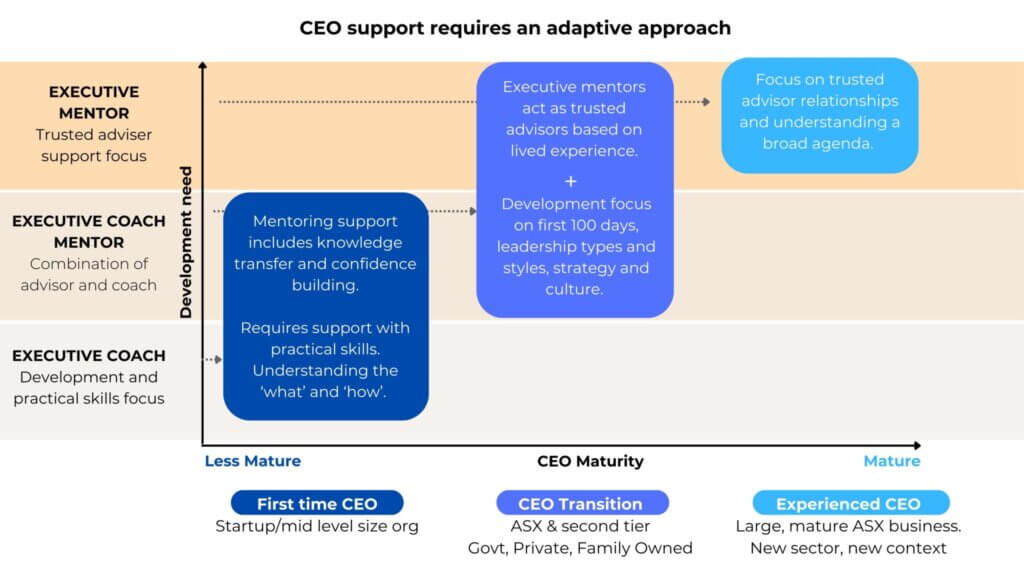CEOs have a high rate of failure when they step into a new role. Some estimates indicate outright failure of CEOs in the first 18 months of their tenure at 38% to 50%. Other sources suggest figures as high as 50-70%.
The subsequent cost to an organisation is eye-wateringly high. The right type of coaching and mentoring helps minimise failure and accelerates success. However, CEOs fail for different reasons, based on their level of maturity and the size and complexity of their organisation.
Therefore, to ensure success, the coaching intervention needs to be aligned to the specific developmental needs of the CEO. This process of aligning a coach or mentor to the CEO’s unique context requires careful diagnostics by experienced professionals, and an executive coach or mentor who themselves have breathed the thin air of being a CEO and can take a highly adaptive and highly nuanced approach to support the development needs of the CEO.
Why do new CEOs fail?
Entry into the CEO role can look different depending on the organisation size, whether they are an internal or external appointment, the sector, the type of company and many other variables. Research shows that internal CEOs improve long-term performance and engage in less strategic change, while hiring an outside CEO leads to more strategic change that results in lower long-term performance [2]. Many CEOs reach this north star due to their potential and their performance within their functional area of the organisation.
However, once a new CEO commences in the role, regardless of whether they have been an internal or external hire, oftentimes they face a steep learning curve as they confront issues like:
- Navigating Board relationships and behaviours
- Building Executive Team cohesion and effectiveness
- Understanding nuances of the company, territory, country
- Understanding regulatory and governance requirements
- Managing broader stakeholder relationships such as internal teams, external stakeholders and shareholders
- Macro issues such as global trade regulations, understanding distribution channels etc
- Identifying and implementing organisation-wide cost reduction programs
- Assessing, adopting or adjusting and embracing the company culture.
In this article, three of SMG’s most senior Executive Leadership Coaches provide a unique vantage point. Through their extensive executive coaching and mentoring engagements with CEOs and Senior Executives in the sector—as well as through their current Board Directorships—Virginia Mansell, Kerrie Kelly and Mark Devadason provide a valuable perspective on leading through change.
Experienced CEOs liken it to a pressure cooker environment, and whilst many believe they can learn on the job, this can lead to a wake of collateral damage without the right support.
Research from the University of Southern Carolina, indicates that the primary cause of external failures appears be an inability to develop trusting relationships, particularly with members of the Executive Leadership Team (ELT). Other sources assert that a whopping 82% of new CEOs fail because they don’t build relationships with their people.
Another critical relationship is that of the CEO, Board and Chair. Australian Institute of Company Directors, highlights that when the partnership between a board and CEO – and in particular, between chair and CEO – is dysfunctional, it is only a matter of time before it affects the organisation’s overall performance.
In times of high pressure, even the best leaders can revert to negative behaviours and fail to listen to all stakeholders. Stress can result in significant changes to behaviour patterns, which at the time may not be realised by the leader but can leave a lasting impact on their executive team, and the wider organisation. CEOs need to be able to maintain a sense of calm and order as they lead their organisations through challenges.
A CEO’s primary responsibility — company decision making—accounts for 45 percent of a company’s performance [1]. The flow on effect of poor decisions made by an underperforming or unprepared CEO, can be eternally damaging to a company’s reputation and amplify poor business performance.
Executive Coach Mentor, Scott Levy, indicates that feeling isolated is a reoccurring theme often cited by CEOs during Executive Coaching sessions. CEOs are often faced with weighty decisions that have lasting impacts, particularly on their people. Being the person responsible for these decisions can take its toll.
“You’re under a magnifying glass, you’re being scrutinised from all angles by everybody. And everything you say and everything you do is elevated accordingly.”
– Scott Levy, Executive Coach Mentor
What type of support is available?
Executive Coaching and Executive Mentoring both have key roles to play in supporting a CEO as they navigate their role. But often there is confusion around exactly what the difference is between the two.
Executive Coaching is outcome focused with defined goals both operationally and strategically. Coaches provide insight to develop the vital skills and mindset for overall leadership effectiveness in the current business context.
Executive Mentoring is less focused around goal achievement and instead provides the C-suite executive with a confidential environment to explore their role impact with a trusted advisor. By providing new perspective and insight, mentors enable the executive leader to meet and exceed their professional context-specific objectives.
A third, and more specialised support for CEOs, is the Executive Coach Mentor, which combines aspects of both.
Executive Coach Mentors offer the unique combination of extensive corporate experience in C-level roles, combined with qualifications in behavioural science, executive coaching and in some cases organisational psychology. They can both advise on critical issues the CEO may be faced with, and provide tools and strategies to support behavioural development. They provide a new perspective and can continually challenge the CEO to question and reflect upon their perspectives and assumptions.
Two key areas where Executive Coach Mentors can provide the most impact:
1. Practical knowledge of leading in a CEO role: Their depth of experience allows them to relate to the challenges faced by CEOs, as they have been there themselves. They understand the nuances of relationship management, the high stakes environment, the impact on loved ones at home in the balancing act of work and life. They are the trusted advisor to the CEO, guiding and supporting and providing a ‘black box’ for confidential conversations.
“If I had my time again, I would spend more time developing relationships with the Board Members, rather than just running the business”
– Ian Morrice, Executive Coach Mentor
2. Understanding and developing self-management: Executive Coach Mentors support leaders to anticipate obstacles and challenges early, become more self-aware of their impacts on others and learn new strategies for coping with pressure and managing stakeholders.
“The transition that occurs when first moving into a CEO role is highly complex, so having the trusted advisor beside you in your first 100 days, can make a huge difference”
– Susan Ferrier, SMG C-Level Executive Coach Mentor
Finding the right solution
The positive outcomes that can be gained from a successful executive coaching engagement are immense. According to Forbes “When leadership abilities are honed, the outcomes are multifaceted: improved strategic decision-making, amplified team dynamics and a consequent elevation in overall organisational efficacy.”
This is further supported by coaching outcomes identified in client impact reports from Stephenson Mansell Group clients, which include:
- Increased levels of confidence in managing their role
- Increased ability to cope and manage effectively in times of stress
- Stronger employee engagement as a result of better leadership
- Longevity in CEO role
- Agility and capability to lead through challenging circumstances like global market shifts, mergers and acquisitions.
Finding the right match is critical in setting the coaching pair up for success. The coachee needs to be open to being coached and putting in the work required to reap the rewards.
To assist CEOs and executive leaders preparing for transition to C-Suite roles, we have developed a model to identify the type of executive coaching and or mentoring CEOs should consider at the various stages of their professional career.

Persona 1 – First time CEO of smaller organisation/Start up
First time to C-suite but has advanced development (requires some mentoring in specific areas). Executive Coaching period (6-12 months).
Priorities:
- Shifting from working in the business to on the business
- Understanding the WHAT and HOW
- Developing key skills in guiding and supporting
- Strategy and structure of team
- Leadership and culture strategy
Coaching can support with:
- How to be a successful CEO
- How to navigate the role
- Understanding behaviours (self)
- Reframing from functional area to org-wide focus
Persona 2 – New to CEO role of a large global organisation, and/or ASX
Primary focus on first 100 days. ECM assignments generally range from 6-18 month duration.
Priorities:
- Managing Stakeholders
- Strategy and Structure of team
- Leadership and culture strategy
- Team Effectiveness
Executive Coaching and Mentoring can support with:
- Bring a trusted advisor
- Navigating dynamics of relationships at CEO level
- Shifting from functional area to all of org
- Building networks
Persona 3 – CEO of ASX business
Focus on broader agenda and macro issues. Executive Mentoring period (6-12 months).
Priorities:
- Stakeholders – micro and macro
- Agility around decision making
- Understanding the market dynamics
- Board relationships and agendas
- Aligning organisational priorities
Executive Mentoring, can support with:
- Navigating disruption
- Stakeholder management
- A safe space for confidential discussions
The benefits of establishing a trusted relationship with an Executive Coach extend beyond individual outcomes. In the vast majority of engagements facilitated by Stephenson Mansell Group over the last 26 years, outcome reporting demonstrates that the positive impacts extend beyond the individual to the Executive team, the wider organisation, and in some cases the industry and community.
To discuss your needs, or that of your team, please contact us.
[1] Chris Bradley, Martin Hirt and Sven Smit, Strategy Beyond the Hockey Stick: People, Probabilities and Big Moves to Beat the Odds, Hoboken, NJ: John Wiley & Sons, 2018.
[2] Donald J. Schepker, Youngsang Kim, Pankaj C. Patel, Sherry M.B. Thatcher, Michael C. Campion, CEO succession, strategic change, and post-succession performance: A meta-analysis.













